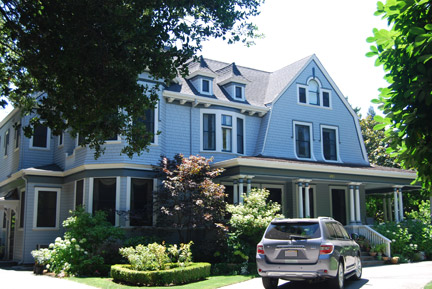 Palo Alto Stanford Heritage
Palo Alto Stanford Heritage 
When Leland and Jane Lathrop Stanford opened their university in 1891, the faculty numbered fifteen, one of whom was Fernando Sanford, head of the Physics department. As the university grew, the need for faculty housing became critical, but was hampered by the university’s own housing policy. Professors were required to spend a minimum of $4,000 on construction, plus the land beneath the house could only be leased, not purchased. Sanford, who became a respected and beloved professor, wryly likened the campus to a “hayfield” and was amused that his colleagues in the East thought Stanford paid “big salaries.” Sanford and his wife, Alice, as did many professors, opted to build a house in Professorville on land not controlled by Stanford.
Chicago architect, Frank McMurray, a former student of Sanford’s, was chosen as architect, and Quinn and Upham were the contractors. By 1895, Fernando and Alice had moved into their fourteen–room house with their two children: six year old son, Burnett, and three year old Alice. The architectural style of the house is Queen Anne, popular in America from 1880–1900, with touches of Colonial Revival. Although Queen Annes presented an asymmetrical, ornate exterior, their interiors were more “modern” with spaces flowing freely from one room to another.
An elegant columned porch with double and triple clusters of Classical columns enfolds the facade and right side of 450 Kingsley. A dominant gable roof, sheltering the second–story and attic, is centered over the front porch. The second–story projects slightly over the porch and has splayed walls, creating the illusion that the gabled roof is actually a gambrel roof. A Colonial Revival motif is seen in the Palladian window in the attic area and completes this dramatic approach to the house. There is an ox-eye window at the side of the tower, while the remaining are double hung of varying sizes. Another interesting attic feature is the twin dormers sitting atop a second–story bay window. Their quaintly shaped roofs give a whimsical air to this 5,500 square foot, three–story building. A mandatory Queen Anne element is seen at the left corner in the four–sided tower whose helmet roof is topped by a finial.
The Queen Anne style used exterior wall surfaces as primary decorative elements. Fish scale shingles and elaborate moldings, as well as an unusual arch cantilevered over the second story on a side gable, are illustrative of this. The Sanford house does not display the gingerbread aesthetic of earlier Queen Annes. While it employs motifs typical of the genre, such as gables, dormers, a patterned chimney and a tower, it does so in a grander and more sophisticated fashion.
As a member of Stanford’s “old guard”, Professor Sanford exercised significant influence on the fledgling University’s policies. Among his innovations were the formulation of Stanford entrance requirements, the founding of the Science Association and the introduction of the laboratory method for instruction of undergraduates. Sanford’s zest for research had been fostered during his two years of graduate study in Berlin from 1886–1888. Working with Hermann Helmholtz, a noted physicist, he became familiar with the cathode rays generated in vacuum tubes when a voltage was applied across separate electrodes, as previously studied by Heinrich Hertz and Philipp Lenard. Helmholtz wanted his student to reject Stanford’s offer of employment and return to Berlin. Had Sanford taken Von Helmholtz’s advice, he, not Röntgen, might have been credited with the discovery of the x–ray.
Sanford continued his Berlin work at Stanford, sometimes in the lab he set up in the barn behind 450 Kingsley. On January 6, 1893, he described his discovery of “electric photography” in a letter published in The Physical Review. A subsequent article describing this work was published in The San Francisco Examiner entitled “Without Lens or Light, Photographs Taken with Plate and Object in Darkness.” On November 8, 1895, German physics professor Wilhelm Röntgen stumbled on X-rays while experimenting with Lenard’s and Crookes’ tubes and began studying them. He wrote an initial report "On a new kind of ray: A preliminary communication" and on December 28, 1895 submitted it to the Würzburg Physical–Medical Society journal. This was the first paper written on X–rays and submitted to a wider audience.
Although X–rays were generated and detected by Fernando Sanford, he was to join the legion of scientists worldwide whose fame and potential Nobel Prize were eclipsed. On a more local level, since his barn/lab is now used as a garage, his name can be entered into the list of well–known Palo Alto inventors who began their work in a garage. ©
Margaret R. Feuer
PAST, May 2, 2014
E-mail us at either webmaster@pastheritage.org or president@pastheritage.org.
![]() Palo Alto Stanford Heritage—Dedicated to the preservation of Palo Alto's historic buildings.
Palo Alto Stanford Heritage—Dedicated to the preservation of Palo Alto's historic buildings.
Copyright © 2015 Palo Alto Stanford Heritage. All rights reserved.